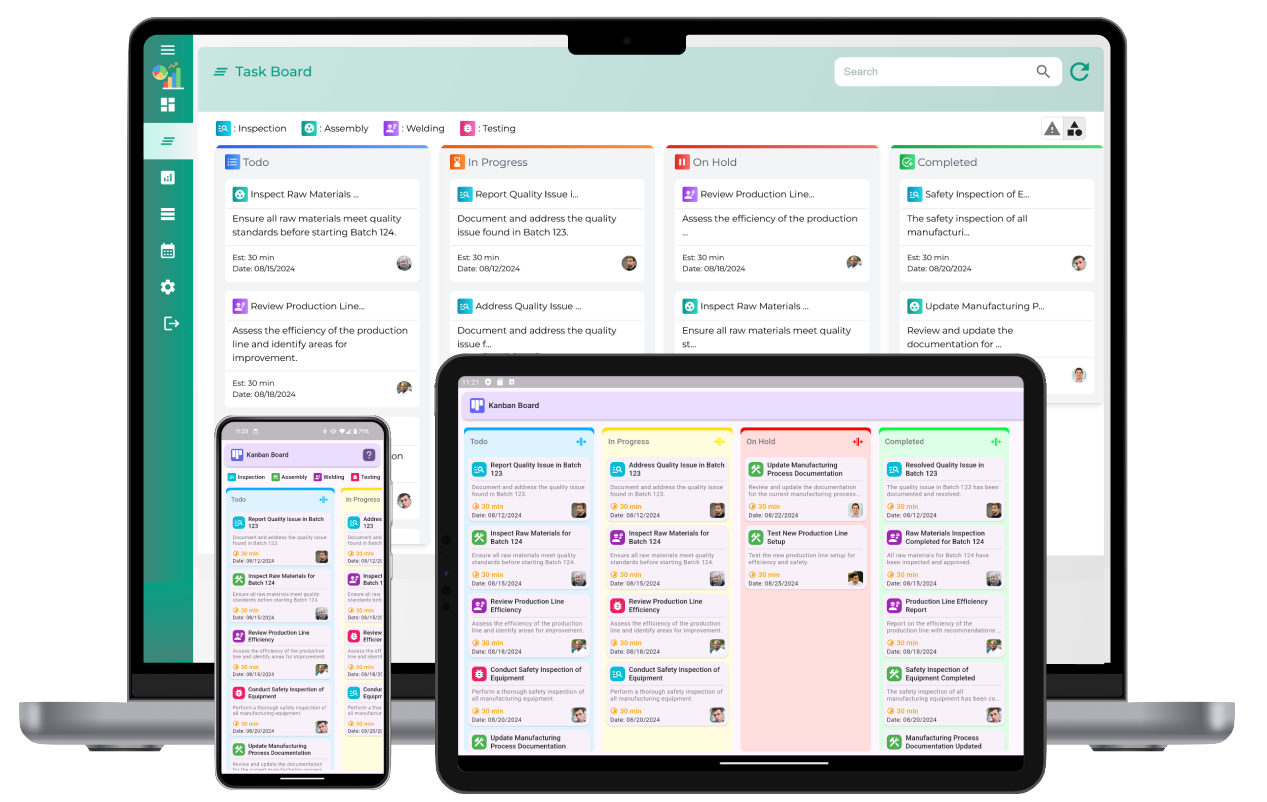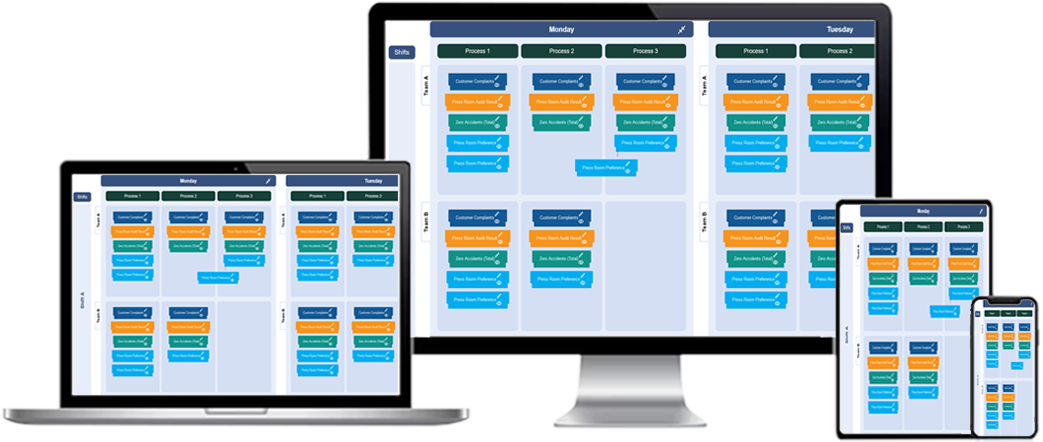In manufacturing environments, efficient process management is crucial to maintaining productivity, reducing waste, and ensuring smooth operations. Among the most widely used tools for managing workflows are the TCard board and the Kanban board. Both systems provide a visual approach to managing tasks and processes, but they each offer distinct features and benefits tailored to different manufacturing needs.

What is a Kanban Board?
Kanban is a visual workflow management tool that originated in lean manufacturing principles and has since been adopted in various industries, including software development, project management, and manufacturing. A Kanban board typically consists of columns representing different stages of a process, such as "To Do," "In Progress," and "Completed." Tasks, often represented by cards or sticky notes, are moved across these columns to reflect their progress. The key principle behind Kanban is to visualize the flow of tasks and limit work in progress (WIP) to avoid bottlenecks and ensure smooth production.
In manufacturing, Kanban is often used to manage inventory, production scheduling, and supply chain processes. The WIP limits help maintain a steady flow, ensuring that the manufacturing line operates efficiently without becoming overloaded with tasks. Kanban boards can be physical or digital and are often used to track the progress of work items or materials throughout the production process.

What is a TCard Board?
The TCard board is another visual task management system that uses cards (TCards) to represent tasks or work items. These cards are moved between columns or stages to track their progress. While similar to Kanban boards, TCard boards are often more flexible and customizable. TCard boards are commonly used in manufacturing environments for process management, inventory control, and task scheduling. They can be adapted to a wide range of workflows and offer greater versatility compared to Kanban boards.
TCard boards typically feature columns that represent different stages of a process, such as "Pending," "In Progress," and "Completed." However, unlike Kanban boards, TCard boards can include more specific categories, such as "Inspection," "Assembly," "Packaging," or "Quality Check," depending on the nature of the manufacturing process. The flexibility of TCard boards allows organizations to tailor the system to their unique operational requirements.
Key Differences Between Kanban and TCard Boards for Manufacturing
1. Flexibility and Customization
One of the major differences between Kanban and TCard boards is their level of customization. Kanban boards are relatively standardized, typically featuring columns for "To Do," "In Progress," and "Done," with WIP limits applied to ensure smooth workflow. This simplicity makes Kanban boards easy to set up and use but may not fully accommodate the diverse and complex needs of a manufacturing environment.
In contrast, TCard boards are highly customizable, offering more flexibility in how tasks are organized and tracked. Manufacturers can create additional columns based on their specific process stages, such as assembly, inspection, testing, and packaging. This ability to customize columns and workflows makes TCard boards more adaptable to different manufacturing processes, from assembly lines to inventory management. Teams can also color-code the TCards to indicate task priorities, departments, or team members responsible for each task.
2. Workflow Management and Task Tracking
Kanban boards are focused on streamlining workflow by visually tracking tasks as they move through different stages. This "flow" approach is ideal for managing continuous production processes and minimizing downtime. By using WIP limits, teams can ensure that the production line is not overloaded, preventing bottlenecks and promoting a steady pace of work. Kanban is particularly effective in environments where tasks move in a linear sequence and where work items can be managed in a consistent manner.
While TCard boards can also track tasks through stages, they provide more granular control over task categorization and management. TCard boards allow for detailed task tracking and can be adapted to track multiple parallel processes. For example, in a manufacturing environment, tasks can be categorized by different departments (e.g., assembly, packaging, quality control) or priorities (e.g., urgent, medium, low). This level of detail makes TCard boards ideal for managing complex workflows with multiple interdependent tasks.
3. Inventory and Resource Management
Kanban boards are particularly useful for inventory and resource management, especially in a just-in-time (JIT) manufacturing environment. The Kanban system uses cards to represent inventory items or production tasks, helping to manage materials and components as they move through the supply chain. This method ensures that inventory is replenished only when needed, reducing waste and storage costs. Kanban boards are also beneficial for tracking production schedules and ensuring that resources are used efficiently throughout the manufacturing process.
On the other hand, TCard boards can also support inventory management but are more versatile when it comes to tracking resources across multiple stages of production. For example, manufacturers can use TCard boards to track the availability of raw materials, production schedules, and even the specific machines or tools required for each task. This added flexibility helps teams manage resources more effectively, especially in environments with more complex or variable workflows.
4. Simplicity vs. Detail
Kanban boards excel in simplicity and ease of use. The standardized structure of a Kanban board, with its focus on WIP limits and visual task flow, makes it easy for teams to understand and implement. This simplicity makes Kanban boards ideal for smaller teams or environments where tasks follow a clear, linear sequence. The focus on flow ensures that teams are always aware of which tasks need attention and which are already in progress.
In contrast, TCard boards provide greater detail and versatility, allowing teams to track tasks in a more granular way. While this added complexity can be beneficial in manufacturing environments with multiple processes or stages, it may require more effort to set up and manage. Teams need to carefully customize the TCard board to suit their workflow, which can take more time and resources initially. However, this level of detail provides better visibility into task priorities, resource allocation, and production timelines.
Which One is Right for Your Manufacturing Process?
Both Kanban and TCard boards offer valuable benefits for manufacturing process management, and the best choice depends on the specific needs of your operation. Here’s a quick breakdown to help you decide:
- Choose Kanban if: You need a simple, visual tool to manage continuous workflows, track tasks through standard process stages, and limit WIP. Kanban is ideal for production lines or environments where efficiency and streamlined task flow are key priorities.
- Choose TCard if: You need greater flexibility and customization to track tasks across multiple stages, departments, or workflows. TCard boards are perfect for manufacturing environments with complex or variable processes, where task categorization and resource management are important.
What is a TCard Board for manufacturing process management?
A TCard board is a visual management tool used in manufacturing to track tasks and work items as they move through different stages of production. It uses color-coded cards to represent tasks, and the cards are moved across columns to reflect the status of the work.
What is a Kanban Board for manufacturing process management?
A Kanban board is a visual tool used in manufacturing to manage workflows by limiting the amount of work in progress (WIP) at each stage. Tasks are represented by cards that move through columns, with a strong focus on optimizing the flow of materials and information throughout the process.
What are the key differences between TCard and Kanban boards for manufacturing?
The key difference lies in structure and focus: TCard boards are more flexible and customizable, suitable for simpler workflows, while Kanban boards emphasize limiting WIP and optimizing workflow efficiency through a structured approach to task management.
How does a TCard board help in managing manufacturing processes?
A TCard board helps by providing a visual representation of the manufacturing process, making it easier to track progress, identify bottlenecks, and manage tasks at different stages of production. Its simplicity allows for quick updates and an intuitive system for task management.
How does a Kanban board help in managing manufacturing processes?
A Kanban board helps by visualizing the entire production process, allowing teams to track progress, manage inventory levels, and ensure a smooth flow of tasks. Its focus on limiting WIP helps maintain efficiency, prevent overproduction, and optimize resource utilization.
Which board is more effective for visualizing production workflows: TCard or Kanban?
Both boards are effective, but Kanban boards are particularly well-suited for manufacturing environments where controlling the flow of work and limiting WIP is critical. TCard boards are better for simpler workflows and offer more customization for visualizing tasks.
Can both TCard and Kanban boards be used to track inventory in manufacturing?
Yes, both boards can be used to track inventory in manufacturing. Kanban boards help by visualizing inventory flow and managing stock levels, while TCard boards can track inventory tasks and stages to ensure timely processing of materials.
How does a TCard board improve task tracking in manufacturing?
A TCard board improves task tracking by providing a simple, visual method for moving tasks through production stages. It allows team members to easily see the status of each task and ensure no tasks are overlooked in the process.
How does a Kanban board help with lean manufacturing principles?
A Kanban board supports lean manufacturing by emphasizing the flow of work, reducing waste, and limiting WIP. It ensures that tasks are completed only when resources are available, preventing overproduction and streamlining processes.
Which board better handles work-in-progress (WIP) limits: TCard or Kanban?
Kanban boards are designed specifically to handle WIP limits by visually showing how much work is in progress at each stage of production. This helps prevent bottlenecks and ensures that the flow of work is maintained at an optimal level. TCard boards can also manage WIP but are less structured than Kanban boards in this aspect.
Which board is more flexible for custom workflows in manufacturing: TCard or Kanban?
TCard boards are more flexible for custom workflows because they allow you to design and organize stages according to the specific needs of your manufacturing process. Kanban boards, while flexible, typically follow a more rigid workflow structure centered around WIP limits.
How does a Kanban board help with reducing production bottlenecks?
A Kanban board helps reduce bottlenecks by visually highlighting where tasks are getting stuck in the workflow. By limiting WIP, it ensures that no part of the process becomes overloaded, allowing tasks to move smoothly through each stage of production.
Can a TCard board be adapted for more complex manufacturing processes?
Yes, TCard boards can be adapted for more complex manufacturing processes by adding additional columns or categories to represent more stages in the production process. They are highly customizable, allowing you to map out detailed workflows and track progress at each stage.
How do TCard and Kanban boards help improve team communication in manufacturing?
Both TCard and Kanban boards improve communication by providing a clear, visual overview of tasks and their statuses. This helps teams collaborate more effectively, ensuring everyone is aware of the current state of production and any potential issues.
Which board is better for optimizing the overall manufacturing process: TCard or Kanban?
Kanban boards are generally better for optimizing the manufacturing process due to their focus on managing WIP, improving workflow, and reducing inefficiencies. TCard boards are more flexible and can be used effectively in less complex environments but may not offer the same level of process optimization as Kanban.